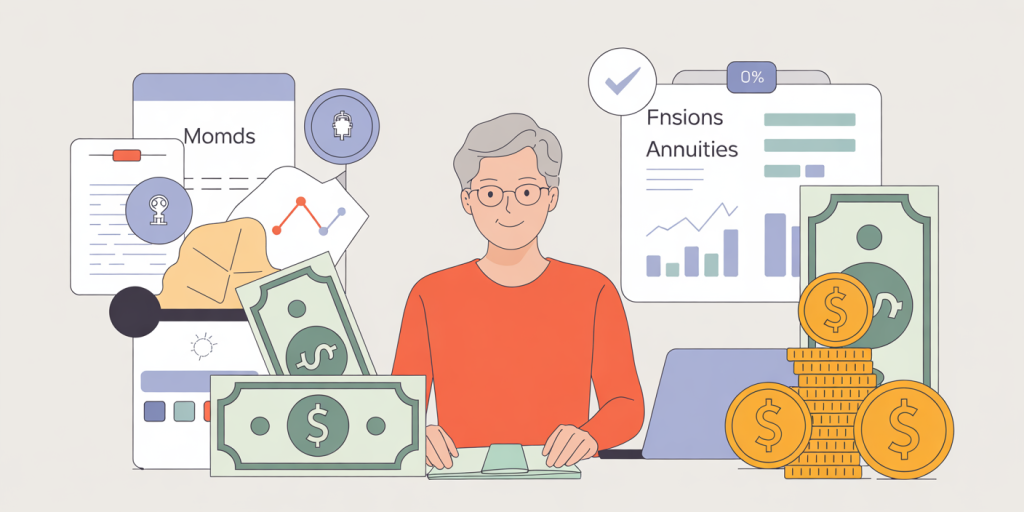Fixed Income vs. Variable Income: Key Differences and Which One to Choose
Anúncios
In the world of personal finance and investment, understanding the nuances between fixed income and variable income is crucial. These two income streams offer distinct advantages and drawbacks, influencing financial stability, risk appetite, and long-term wealth creation. Whether you are an investor deciding on asset allocation or someone choosing a career path, recognizing the key differences between fixed and variable income will help you make informed, strategic decisions.
Contextualizing Fixed and Variable Income
Anúncios
Fixed income generally refers to earnings that remain steady and predictable over time. Examples include salaries, pensions, annuities, and interest payments from bonds. Investors and employees alike value fixed income for its reliability and stable cash flow. According to the Investment Company Institute, fixed income assets made up about 30% of global assets under management in 2023, highlighting its popularity in portfolios aiming for safety and steady returns.
On the other hand, variable income is income that fluctuates depending on factors such as performance, sales, market conditions, or profit sharing. Freelancers, sales personnel earning commissions, entrepreneurs, and shareholders experiencing dividend variability often fall under this category. Variable income carries higher risk but potentially higher rewards, attracting those with a tolerance for uncertainty and a desire for growth.

Understanding Fixed Income: Security and Stability
Fixed income sources are characterized mainly by their predictability. For example, a corporate bond paying a 5% annual coupon will usually do so every year until maturity, barring default. This steadiness offers peace of mind, especially for retirees or individuals who prioritize financial security. According to Morningstar’s 2023 data, the average annual return of investment-grade bonds was approximately 3%–4%, providing moderate returns but lower volatility compared to stocks.
Beyond investments, fixed income includes stable wages and pensions. Consider a government employee with a fixed salary of $60,000 per year. This predictable income allows for structured budgeting, enabling the individual to plan expenses with confidence. Similarly, annuities purchased from insurance companies provide retirees with guaranteed monthly payments, shielding them from market downturns.
Fixed income is often recommended for conservative investors seeking steady cash flow or those nearing retirement. For instance, a 65-year-old retiree might allocate a significant portion of their portfolio to fixed income to protect their principal and ensure a consistent income stream.
Despite its advantages, fixed income has downsides. Inflation risk is a significant concern. For example, if inflation rises above the bond’s interest rate, the real purchasing power of income declines. Suppose inflation is at 4%, but a bond yields 3%. The investor effectively loses 1% in purchasing power. Additionally, fixed income investments can face interest rate risk: when rates rise, bond prices typically fall, which can lead to short-term losses if bonds are sold before maturity.
Exploring Variable Income: Flexibility and Growth Potential
Variable income is often linked with unpredictability but offers higher growth potential. It includes commissions, profit-sharing, freelance earnings, dividends from stocks, and business profits. For instance, a sales executive earning a base salary plus commission might see total income ranging from $50,000 to $120,000 annually, depending on sales performance.
The volatility in variable income can be both empowering and stressful. Entrepreneurs exemplify this income type, where monthly revenues can drastically fluctuate. A startup founder might earn nothing in the initial months but later reap substantial profits as the company scales. According to the Kauffman Foundation, about 25% of startups generate more than $1 million in revenue within five years, showcasing the upside of variable income tied to business success.
Stock dividends, another form of variable income, depend on company earnings and board decisions. For example, the dividend yields of companies like Apple or Coca-Cola fluctuate based on their quarterly earnings and market conditions.
Variable income suits those who are comfortable with uncertainty and seek growth. Younger professionals or self-employed individuals often embrace variable income for the flexibility and scalability it offers. It also encourages entrepreneurial mindset and innovation.
However, the unpredictability complicates budgeting and financial planning. Sudden drops in income can strain finances, making it necessary to maintain robust emergency funds. Moreover, variable income may face higher tax rates or inconsistent tax payments, requiring careful tax management.
Comparative Table: Key Attributes of Fixed Income vs. Variable Income
| Attribute | Fixed Income | Variable Income |
|---|---|---|
| Predictability | High – steady and reliable | Low – fluctuates based on factors |
| Risk Level | Low to moderate | Moderate to high |
| Income Growth Potential | Limited | High |
| Suitable For | Risk-averse, retirees, conservative investors | Risk-tolerant, entrepreneurs, growth-focused individuals |
| Common Examples | Salaries, pensions, bonds | Sales commissions, dividends, business profits |
| Inflation Sensitivity | High – can erode real returns | Variable – income may increase with inflation |
| Tax Implications | Often stable and predictable | May be irregular and complex |
| Budgeting Ease | Simple | Challenging |
This table helps clarify how fixed and variable incomes meet different financial needs and goals.


Real-World Case Study: Choosing the Right Income Approach
Consider two individuals—Anna, a 55-year-old approaching retirement, and Michael, a 30-year-old tech startup founder. Anna relies mostly on fixed income sources, including her pension and bond investments, to ensure she can cover her living expenses without market volatility impacting her financial security. Her portfolio consists of 70% fixed income and 30% stocks, reflecting her conservative stance.
Michael, by contrast, depends primarily on variable income. His compensation includes equity options, profit shares, and fluctuating dividends from investments in startups. While his income varies wildly year over year, this variability also provides tremendous upside potential. Michael reinvests his earnings into growth opportunities but maintains a small safety net of fixed income investments.
The contrast between Anna and Michael illustrates how income type choices align with life stage, risk tolerance, and financial goals. While Anna’s fixed income offers peace of mind, Michael’s variable income fuels opportunity and wealth accumulation.
Strategic Decision-Making: Which Income Type Should You Choose?
The choice between fixed and variable income depends largely on individual circumstances: Risk tolerance: Conservative individuals, such as those nearing retirement or with dependents, generally prefer fixed income for stability. Time horizon: Fixed income suits short- to medium-term horizons, while variable income benefits from a long-term perspective allowing recovery from income fluctuations. Financial goals: For wealth preservation and steady cash flow, fixed income is suitable. For wealth accumulation and capital growth, variable income is preferred. Market knowledge and involvement: Variable income often requires active management, market understanding, and flexibility, while fixed income can be more passive.
Hybrid models combining both income types are increasingly popular. For example, a 40-year-old professional might keep 50% in a fixed income portfolio and 50% in equities and business ventures, balancing security and growth.
Future Perspectives: Trends Shaping Fixed and Variable Income
The landscape of income sources continues to evolve amid economic shifts, technological advances, and changing employment structures.
Impact of Technology and Gig Economy
The rise of gig and freelance work has made variable income more mainstream. According to a 2023 report by Upwork, 36% of the U.S. workforce participated in freelance work, reflecting a significant shift toward income variability. Remote work and app-based platforms offer new opportunities but also create income unpredictability.
Inflation and Interest Rate Environments
With inflation rates fluctuating globally—averaging around 3.5% in 2023 according to the IMF—fixed income investors face increased complexity. Central banks raising interest rates to control inflation affect bond prices and yields, necessitating more agile fixed income strategies and diversified portfolios to combat eroded purchasing power.
Hybrid Financial Instruments and Products
Markets are responding with innovative assets blending fixed and variable traits. For example, floating rate bonds pay coupons linked to benchmarks like LIBOR, adjusting to market conditions. Similarly, structured products and variable annuities offer customizable risk-return profiles.
Greater Emphasis on Financial Literacy
As individuals engage in diversified income sources, financial literacy becomes paramount. Understanding risk management, tax implications, and portfolio balancing for both fixed and variable income is critical to long-term financial health.
Demographic and Economic Shifts
Aging populations in developed countries increase demand for fixed income solutions for retirees, while younger generations pursue entrepreneurial and variable income pathways. Economic uncertainty amid geopolitical tensions further complicates income planning, making adaptability essential.
In summary, the future calls for tailored income strategies blending fixed security with variable growth potential, aided by education and innovative financial products.
